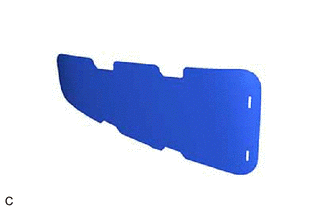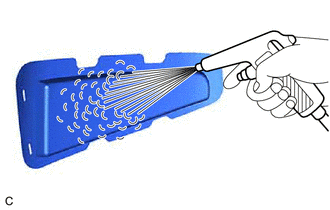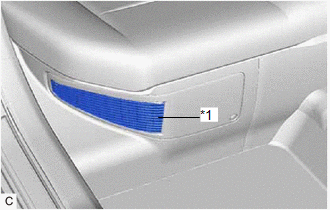Lexus ES: Inspection
INSPECTION
PROCEDURE
1. INSPECT NO. 1 HV BATTERY INTAKE FILTER
HINT:
- If the vehicle is used in an area with heavy traffic or excessive dust, or if the rear seat is used frequently, the No. 1 HV battery intake filter may be clogged. Clean or replace the No. 1 HV battery intake filter as necessary.
- If the message "Maintenance Required for Traction Battery Cooling Parts See Owner's Manual" is not displayed on the multi-information display, clean the No. 1 HV battery intake filter with it installed to the vehicle to prevent clogs.
|
(a) Visually inspect the No. 1 HV battery intake filter. Standard: No clogs or damage. NOTICE:
If the result is not as specified, replace the No. 1 HV battery intake filter. |
|
2. CLEAN NO. 1 HV BATTERY INTAKE FILTER
(a) When removed from the vehicle:
|
(1) Clean the No. 1 HV battery intake filter by blowing compressed air as shown in the illustration. NOTICE:
|
|
(b) When not removed from the vehicle:
|
(1) Clean the No. 1 HV battery intake filter using a vacuum cleaner or equivalent. NOTICE:
|
|
READ NEXT:
 Installation
Installation
INSTALLATION
PROCEDURE
1. INSTALL NO. 1 HV BATTERY INTAKE FILTER
(a) Engage the 2 claws to temporarily install the No. 1 HV battery intake filter
to the battery service hole cover.
(b) Engage th
 Installation
Installation
INSTALLATION
PROCEDURE
1. INSTALL NO. 1 HV BATTERY INTAKE FILTER
(a) Engage the 2 claws to temporarily install the No. 1 HV battery intake filter
to the battery service hole cover.
(b) Engage th
 Brake Fluid (for Gasoline Model)
Brake Fluid (for Gasoline Model)
Components
COMPONENTS
ILLUSTRATION
*1
BRAKE MASTER CYLINDER RESERVOIR FILLER CAP ASSEMBLY
-
-
ILLUSTRATION
*1
FRON
SEE MORE:
 On-vehicle Inspection
On-vehicle Inspection
ON-VEHICLE INSPECTION PROCEDURE 1. INSPECT PARKING BRAKE ACTUATOR ASSEMBLY (for Gasoline Model) HINT: Using the GTS to perform the Utilities allows relays, VSVs and actuators and other items to be operated without removing any parts. This non-intrusive functional inspection can be very useful becaus
 Components
Components
COMPONENTS ILLUSTRATION *A for HV Model *B for Gasoline Model *1 REAR DOOR SCUFF PLATE LH *2 REAR DOOR SCUFF PLATE RH *3 REAR SEAT SIDE GARNISH LH *4 REAR SEAT SIDE GARNISH RH *5 ROOF SIDE INNER GARNISH ASSEMBLY LH *6 ROOF SIDE INNER GARNISH ASSEMBLY RH *7
© 2016-2025 Copyright www.lexguide.net




